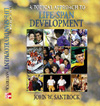 |  Life-Span Development: A Topical Approach John W. Santrock
Biological Process, Physical Development, and Health Motor, Sensory, and Perceptual Developmental
Learning Objectives1.Describe the new look in motor development that has been fueled by Thelen's dynamic systems theory, noting that motor skills are the result of many converging factors, not simply genetics. |
 |  |  | 2.Understand what reflexes are and how they govern the newborn's behavior, looking particularly at reflexes like sucking that are important for survival. |
 |  |  | 3.Discuss the development of gross motor skills (those involved in large motor activities), including:
- how development of posture and walking illustrate the complexity of motor development and the importance of perceptual-motor coupling, the many gross motor milestones that occur in infancy, and cultural variations
- how they improve dramatically in childhood for boys and girls
- their peak from 19 to 26 years of age and their slowdown in the thirties, and how activity and biological health are involved in their slowing for older adults
|
 |  |  | 4.Discuss the development of fine motor skills (those involved in finely tuned motor actions), including:- their milestones in infancy, such the onset of reaching and grasping
- the relationship between increased myelination and development of fine motor skills
- gender differences
|
 |  |  | 5.Explain the role that handedness plays in motor skills and intellect, exploring how genetic and environmental (but not cultural) factors have been proposed to explain handedness. |
 |  |  | 6.Describe the nature of sensation and perception and how they are explained through the ecological view, noting:- the difference between sensation (which occurs when information interacts with sensory receptors) and perception (the interpretation of what is sensed)
- the Gibsons' ecological view that states that perception functions to bring the organism in contact with the environment and increase adaptation
|
 |  |  | 7.Consider the various issues in development of visual perception, such as:- the dramatic increase in infants' visual acuity contrasted with decreasing eye accommodation as we age
- changes in color vision from infancy to childhood to late adulthood
- Fantz's pioneering research with young infants, and how children from 6 to 11 years of age increasingly differentiate various forms
- Gibson and Walk's classic visual cliff study demonstrating that infants have depth perception, and how crawling is linked with decisions infants make on the visual cliff
|
 |  |  | 8.Understand the developmental changes in hearing, pain, touch, smell, and taste from infancy through late adulthood, addressing:- changes in hearing from the fetal period through childhood (during which otitis media may be a problem) to the decline in hearing around age 40
- how newborns can respond to touch and feel pain, and that this sensitivity decreases in late adulthood
- that sensitivity to taste may be present before birth, newborns can differentiate odors, and both smell and taste may decline in late adulthood, although the decline is minimal for healthy adults
|
 |  |  | 9.Explain intermodal perception and perceptual-motor coupling and unification, beginning in infancy with the ability to relate and integrate information about two or more sensory modalities, and how the crude, exploratory forms of intermodal perception present at birth become sharpened over the first year of life as perception and action are coupled and unified. |
|



 2002 McGraw-Hill Higher Education
2002 McGraw-Hill Higher Education